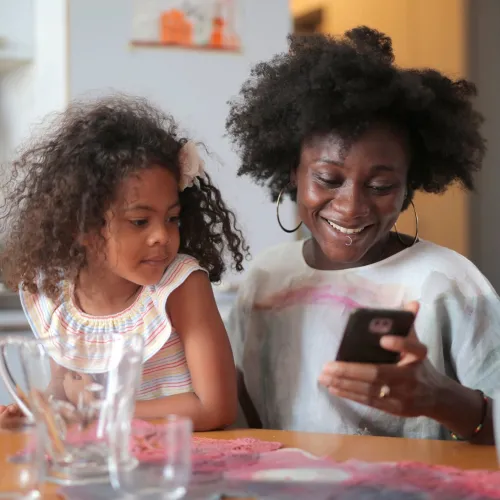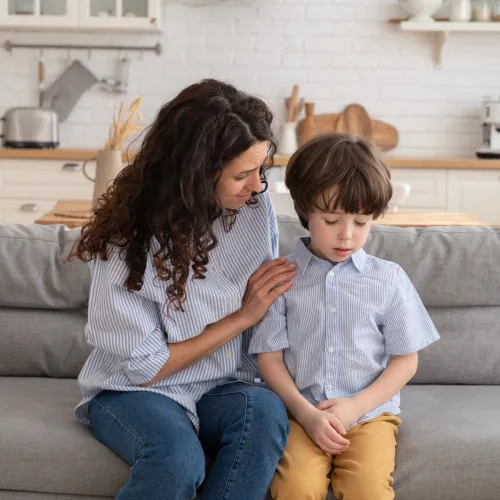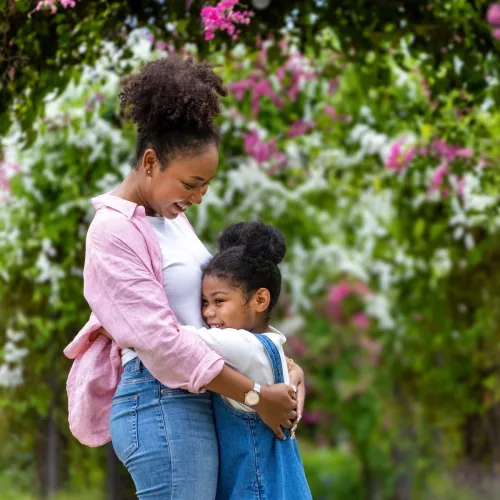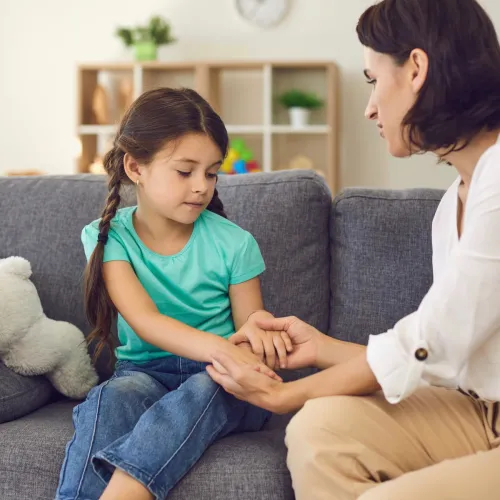Teaching Kids About Healthy Boundaries
Setting healthy personal boundaries, and being able to recognize and heed others' as well, is paramount for building strong relationships on a foundation of respect. But maintaining boundaries can be complicated. And if you're unused to examining your own, it can feel uncomfortable to begin to do so as an adult. That's why it's so important to teach children about healthy boundaries from a young age. The earlier they learn about their own limits and see the importance of respecting other's, the easier it will be for them to navigate healthy relationships as adults.

What are personal boundaries?
The term 'personal boundaries' covers a whole slew of interactions and relationships. Our boundaries will necessarily change depending on the setting, the people with whom we're interacting, and our own comfort. 'Personal boundaries' apply to a variety of situations as well. Boundaries govern our definitions of personal space, how comfortable we are with lending money, whether or not our opinions of ourselves can withstand external pressure, and more. To teach children the importance of personal boundaries, it's helpful to understand the many manifestations those boundaries have in our relationships.
Quality of boundaries
While it is healthy to have personal boundaries, not all personal boundaries, by definition, are healthy. In certain situations, our personal boundaries may be too rigid, preventing adaptation or personal growth. In others, they may be too open, causing us to take on more than we can handle or to be swayed too easily. To teach children about what makes a boundary 'healthy', parents should know how to identify the traits of unhealthy boundaries.
- Rigid boundaries: When personal boundaries become too rigid, they can cause people to become closed-off. They can prevent the establishment of lasting emotional ties in both romantic and non-romantic relationships, as its harder to share thoughts and feelings openly and honestly.
- Porous boundaries: Personal boundaries that lack structure can cause us to become over-enmeshed with other people. People with porous boundaries may have difficulty saying 'no', leading them to be overly involved in and feel responsible for other people's personal dilemmas and drama.
- Healthy boundaries: When our boundaries are healthy, we can identify our own limits, be confident in our opinions, and stand up for ourselves when necessary.
Types of boundaries
Material
Our material boundaries govern how we approach lending money and other possessions. Even young children must be familiar with material boundaries, as parents teach them lessons about sharing or respecting other children's toys and items.
Physical
Physical boundaries affect how we define personal space and our comfort with physical touch. Bodily integrity, or the right to physical autonomy, is an incredibly important lesson for children to learn. Parents can show children how to respect physical boundaries, for example, by not forcing them to hug or kiss family members when they do not wish to do so. This reinforces the fact that people have the right to say 'no' to physical contact.
Mental
Also referred to as intellectual boundaries, mental boundaries allow us to form our own thoughts and help us to navigate discussions and debates. Healthy mental boundaries allow us to hold independent opinions, giving us confidence in our own stances. Too rigid of mental boundaries, however, may cause us to become too set in our ways, unable to grow or change when presented with new information or a new perspective.
Emotional
Emotional boundaries are some of the most important to maintain but can also be the most difficult. Healthy emotional boundaries help us stay independent, allowing us to separate our needs, wants, and emotions from those of our friends and loved ones. They also prevent us from placing unwarranted blame on others for our own emotions or, conversely, accepting blame for others' emotions.
Teaching children healthy boundaries
Set a good example
Like with many other lessons passed on from parents to children, teaching children about healthy boundaries is easier when parents can do so by example. Take stock of your own personal boundaries and do an honest assessment.
Start by asking yourself the following questions. Are you managing your boundaries consistently? Are the boundaries that you set healthy, rigid, or porous? When you have to enforce your boundaries with your children, do you have a discussion with them about why you are doing so?
Check in with yourself periodically about the state of your personal boundaries, keeping them healthy, and your children will have a strong example to follow as they grow up.
Emphasize confidence and emotional intelligence
Healthy boundaries often require us to be confident in our own opinions, desires, and needs. In order to build that confidence, children need to learn how to identify what they need, where their limits are, and the types of interactions with which they are comfortable.
Parents can help children build emotional intelligence through open and honest discussion. Talk about emotions frequently in age-appropriate terms, and encourage them to bring up their feelings without shame. Once your child is old enough, ask questions that will help them gain a better understanding of their motivations and reactions. You can begin with questions like,
- How did that make you feel?
- Why do you think you felt that way?
- Would you do anything differently next time?
Teach them that it's okay to say 'No'
Being able to say 'no' is a basic skill every child should learn as it’s applicable to personal boundaries of all types. Whether it's declining a request to lend money, refusing to accept unwarranted blame, or enforcing your personal space, saying 'no' is a necessary part of many human interactions.
But despite its basic nature, saying 'no' can still cause many of us discomfort, and that discomfort can take some getting used to.
Practice early and often with your child. Run through different scenarios—saying no to a family member asking for a hug, for example, will sound different than saying no to a friend's peer pressure—and emphasize that a simple 'no' is sometimes more than sufficient.
While practicing how to say no, follow-up with discussions about how to react when on the receiving end of one. Understanding the situation from its opposite viewpoint can give your child some much-needed insight. They will learn that another person's 'No' deserves to be respected and that, in turn, can give them confidence in the validity of their own 'no.'
Healthy personal boundaries are essential for healthy relationships, and parents should begin teaching their children about them from a young age. Help them build confidence in their own emotional health by having conversations about the different types of boundaries and why they help us. Establishing healthy boundaries can be tiring, and as they grow, your children may feel uncertain when putting the discussions they had with you into practice. But with love and support, they'll be able to commit to maintaining their personal boundaries and their relationships will be all the stronger because of it.






